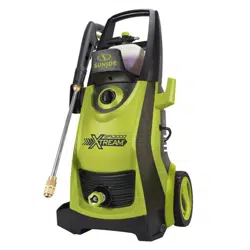Documents: Go to download!
- Owner's manual - (English)
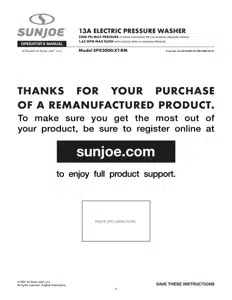
- Know Your Electric Pressure Washer
- Assembly
- Operation
- Storage
- Maintenance
- Disposal
- Troubleshooting
Table of contents
Owner's Guide Tools - Home Improvement
Know Your Electric Pressure Washer
Read the owner’s manual and safety instructions carefully before operating the electric pressure washer. Compare the illustration below to the electric pressure washer in order to familiarize yourself with the location of the various controls and adjustments. Save this manual for future reference.
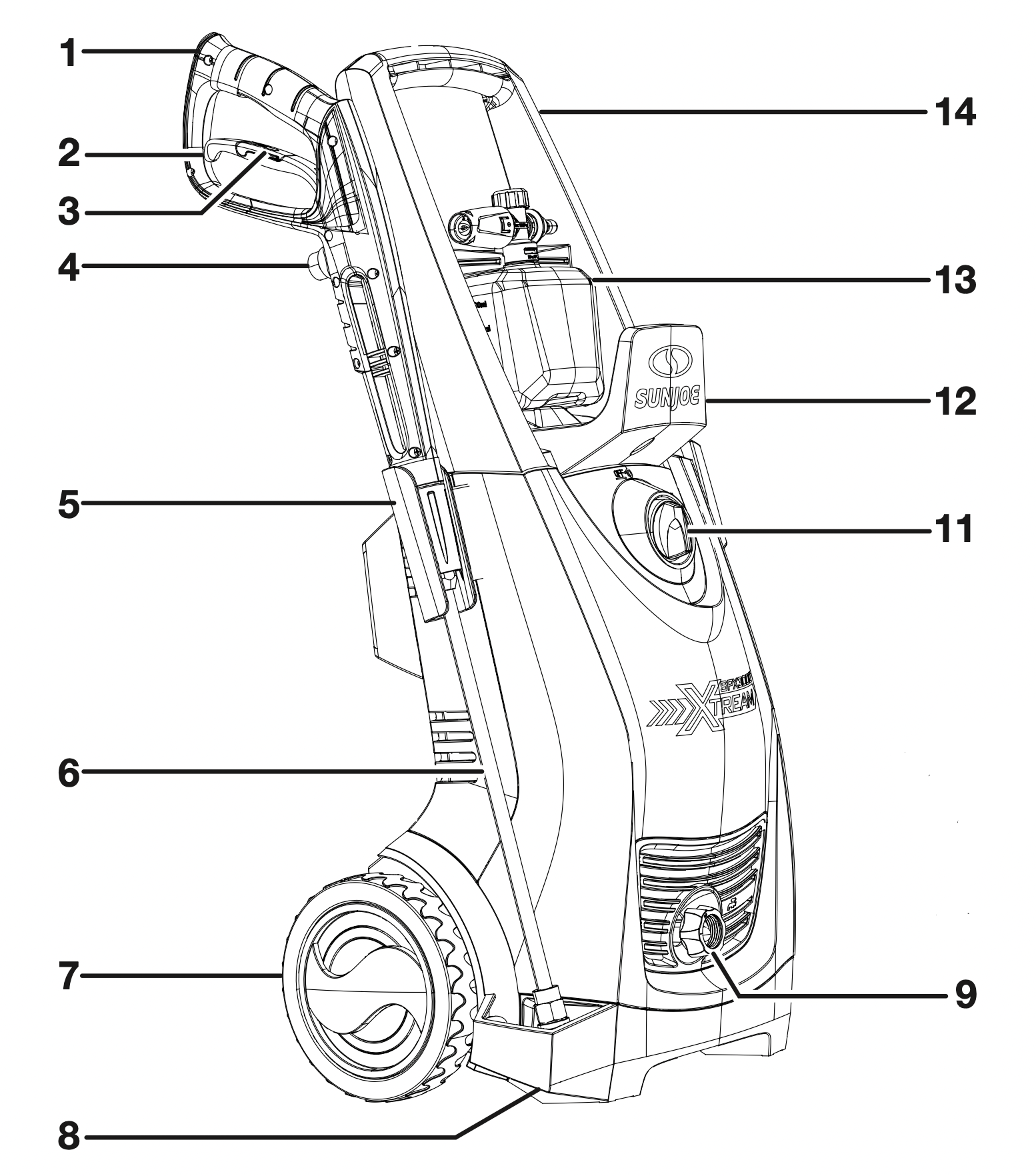

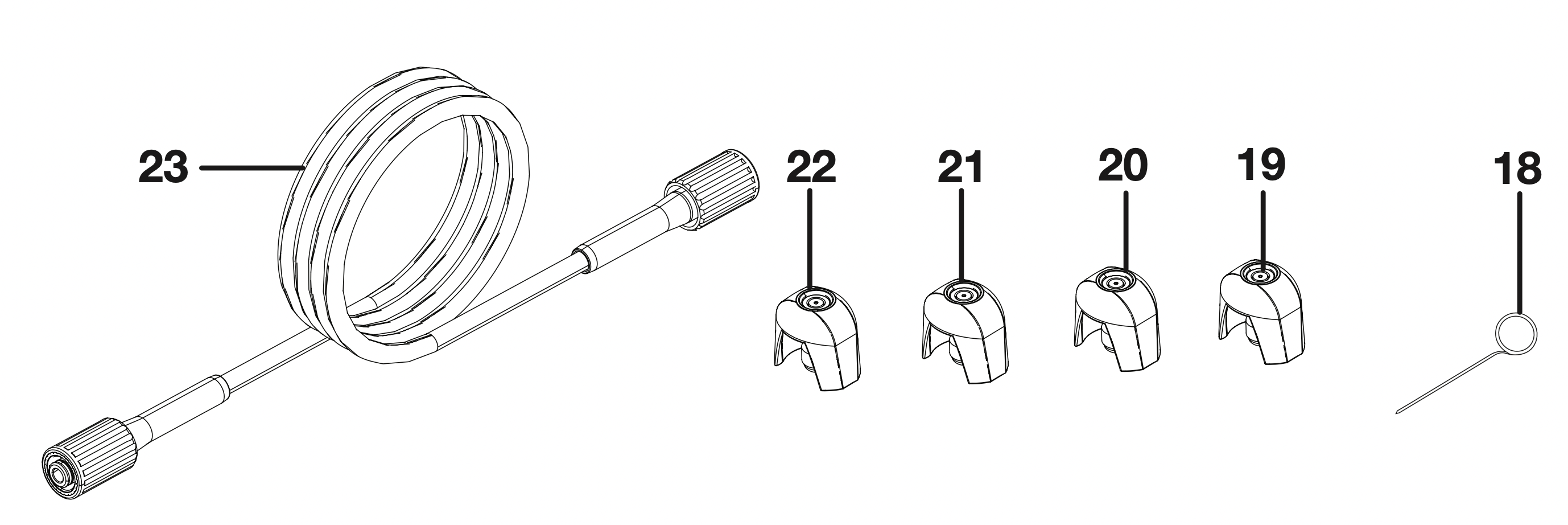
- Trigger gun
- Trigger
- Safety lock
- High-pressure hose connection
- Trigger gun holder
- Stainless steel lance
- Wheel (2)
- Spray wand protector
- Garden hose adapter (female coupler)
- Power cord with GFCI
- On/Off switch
- Hose holder
- Detergent bottle with foam cannon
- Transport handle
- Nozzle storage board
- Cord holder
- Water outlet (high-pressure connection)
- Needle clean-out tool
- 0º Quick-Connect nozzle (red)
- 15º Quick-Connect nozzle (yellow)
- 25º Quick-Connect nozzle (green)
- 40º Quick-Connect nozzle (gray)
- High-pressure hose
Unpacking
Carton Contents
- Electric pressure washer
- Transport handle
- Trigger gun
- Stainless steel lance
- Four (4) Quick-Connect nozzles (0º, 15º, 25º, and 40º)
- Detergent bottle with foam cannon
- Four (4) large screws
- Two (2) small screws
- Spray wand protector
- Trigger gun holder
- Hose holder
- Needle clean-out tool
- High-pressure hose
- Garden hose adapter (female coupler) with two sealing rings
- Manual with registration card
- Carefully remove the pressure washer and check to see that all of the above items are supplied.
- Inspect the product carefully to make sure no breakage or damage occurred during shipping. If you find damaged or missing parts, DO NOT return the unit to the store. Please call the Snow Joe ® + Sun Joe ® customer service center at 1-866-SNOWJOE (1-866-766-9563).
NOTE: Do not discard the shipping carton and packaging material until you are ready to use your new electric pressure washer. The packaging is made of recyclable materials. Properly dispose of these materials in accordance with local regulations.
IMPORTANT! The equipment and packaging material are not toys. Do not let children play with plastic bags, foils, or small parts. These items can be swallowed and pose a suffocation risk!
WARNING! Do not connect to power supply until assembly is complete. Failure to comply could result in accidental starting and possible serious personal injury.
Assembly
- Position the washer as CLOSE as possible to the water supply.
- The washer must be used on a secure and stable surface in a standing, upright position (Fig. 1).
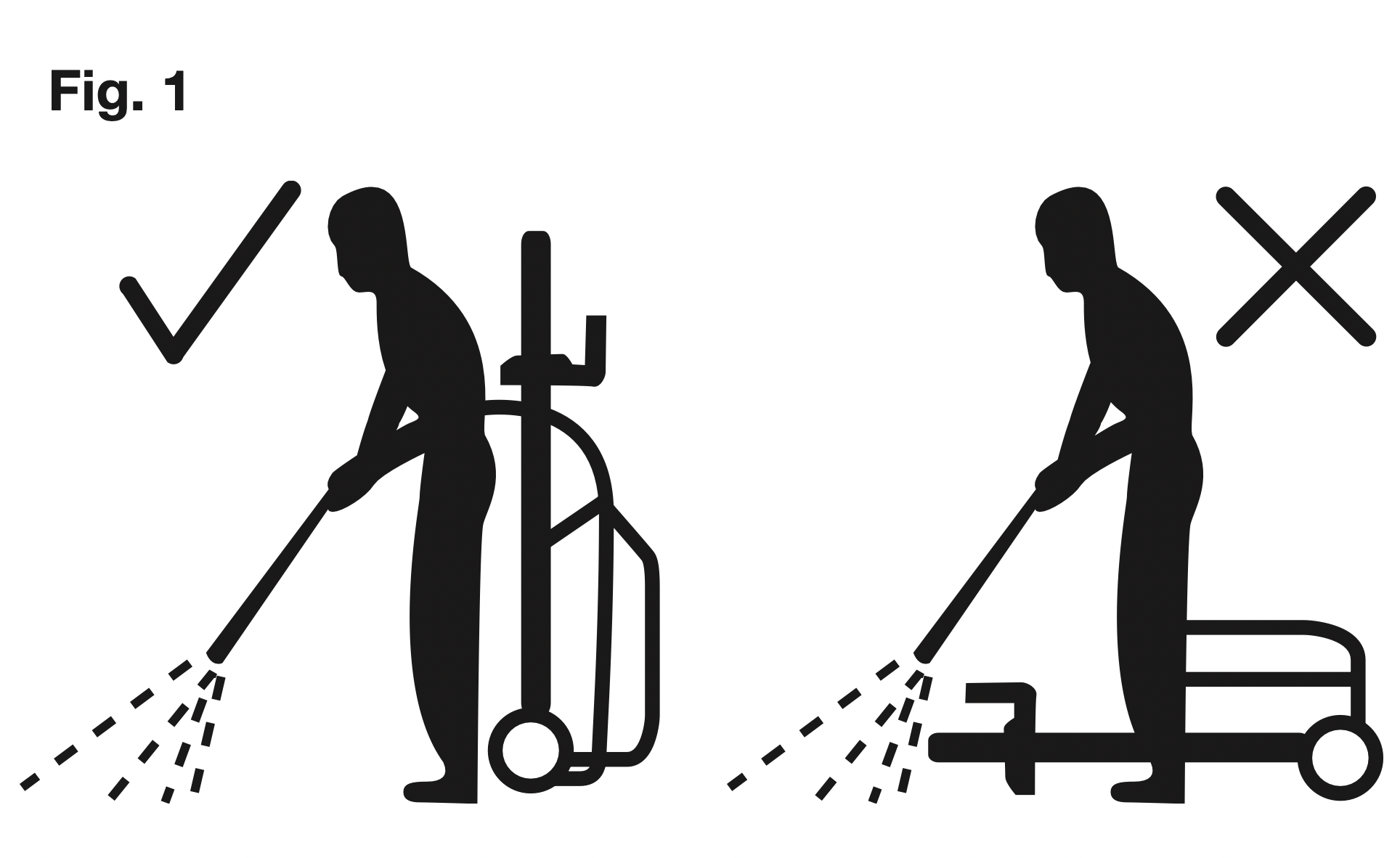
- Slide the trigger gun holder into position (Fig. 2).

- Slide the transport handle into position and secure it with 4 large screws (Fig. 3).

- To assemble the hose holder, slide the holder into position (Fig. 4) and secure it to the unit with one small screw (Fig. 5).


- Click the detergent bottle with foam cannon and the 4 quick-connect nozzles in place in front and back of the nozzle storage board (Figs. 6 - 7).
See other models: SPX2599-MAX-RM SPX2598-MAX-RM SPX4004-MAX-RM SPX3000-MAX-RM SPX7000E-RM
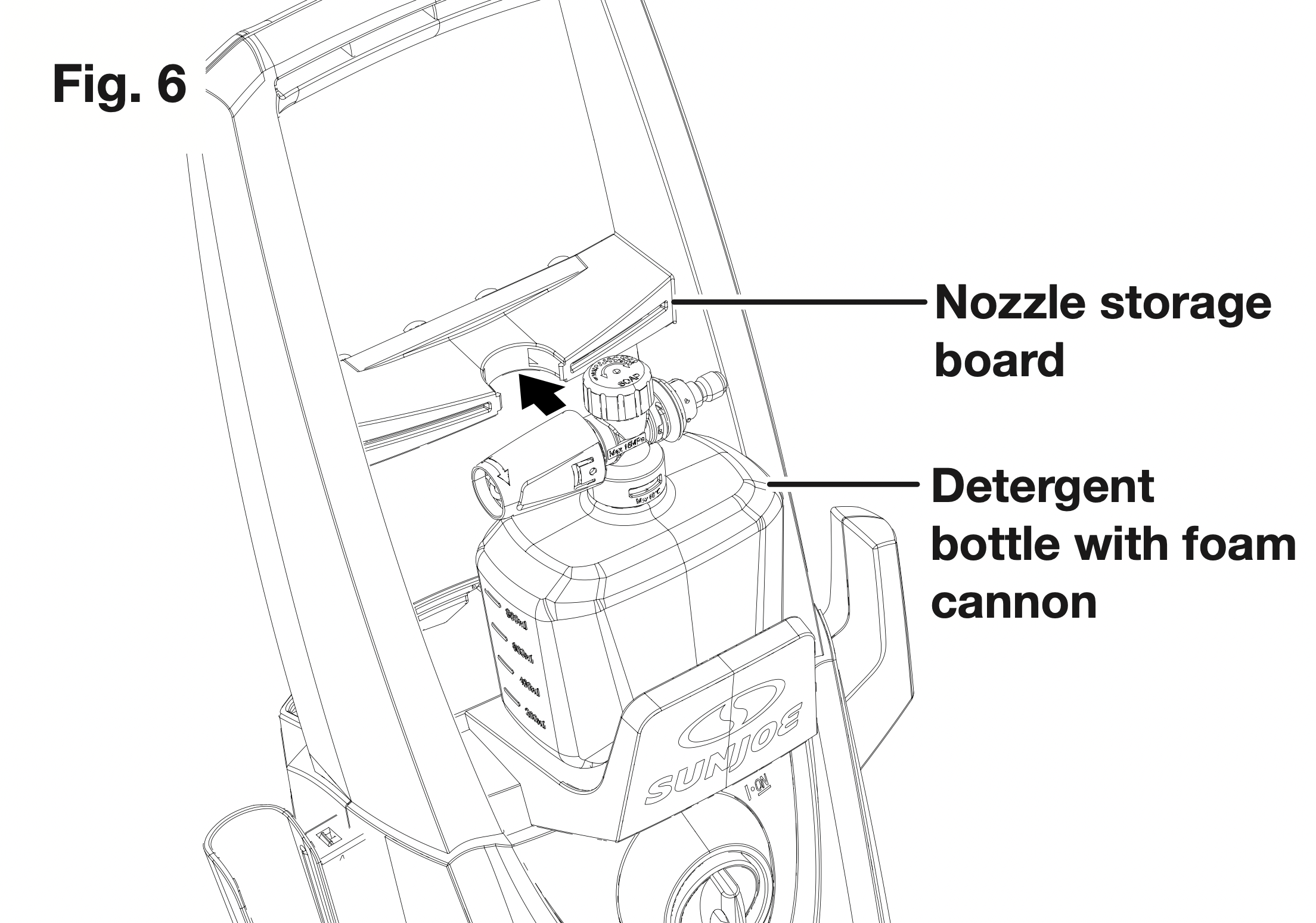

- To assemble the spray wand protector, first snap the tab into the slot located at the bottom left side of the unit, and then secure it in place with the remaining small screw (Fig. 8).
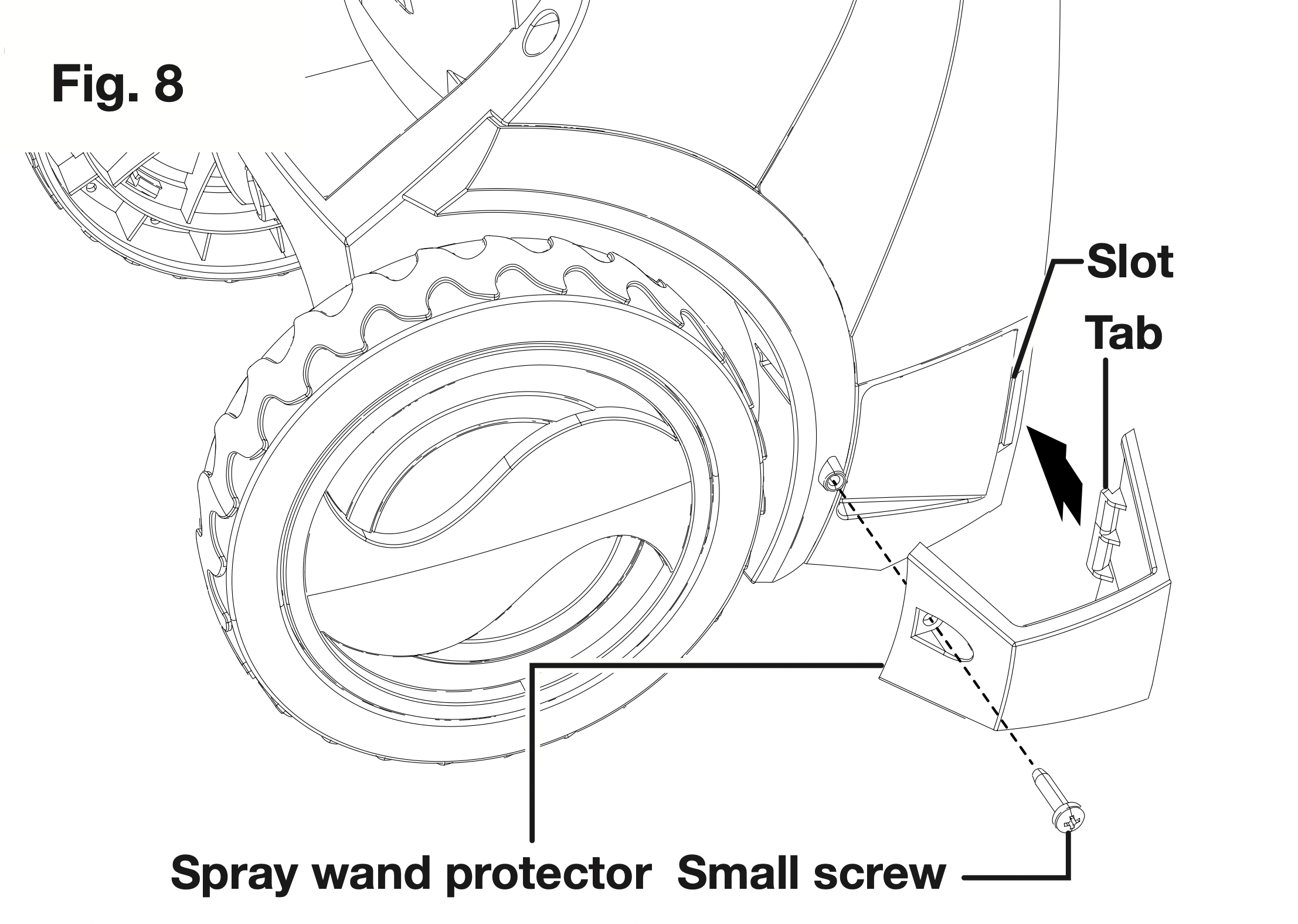
- Fit the stainless steel lance into the trigger gun and rotate the collar until the two parts are completely locked (Fig. 9).
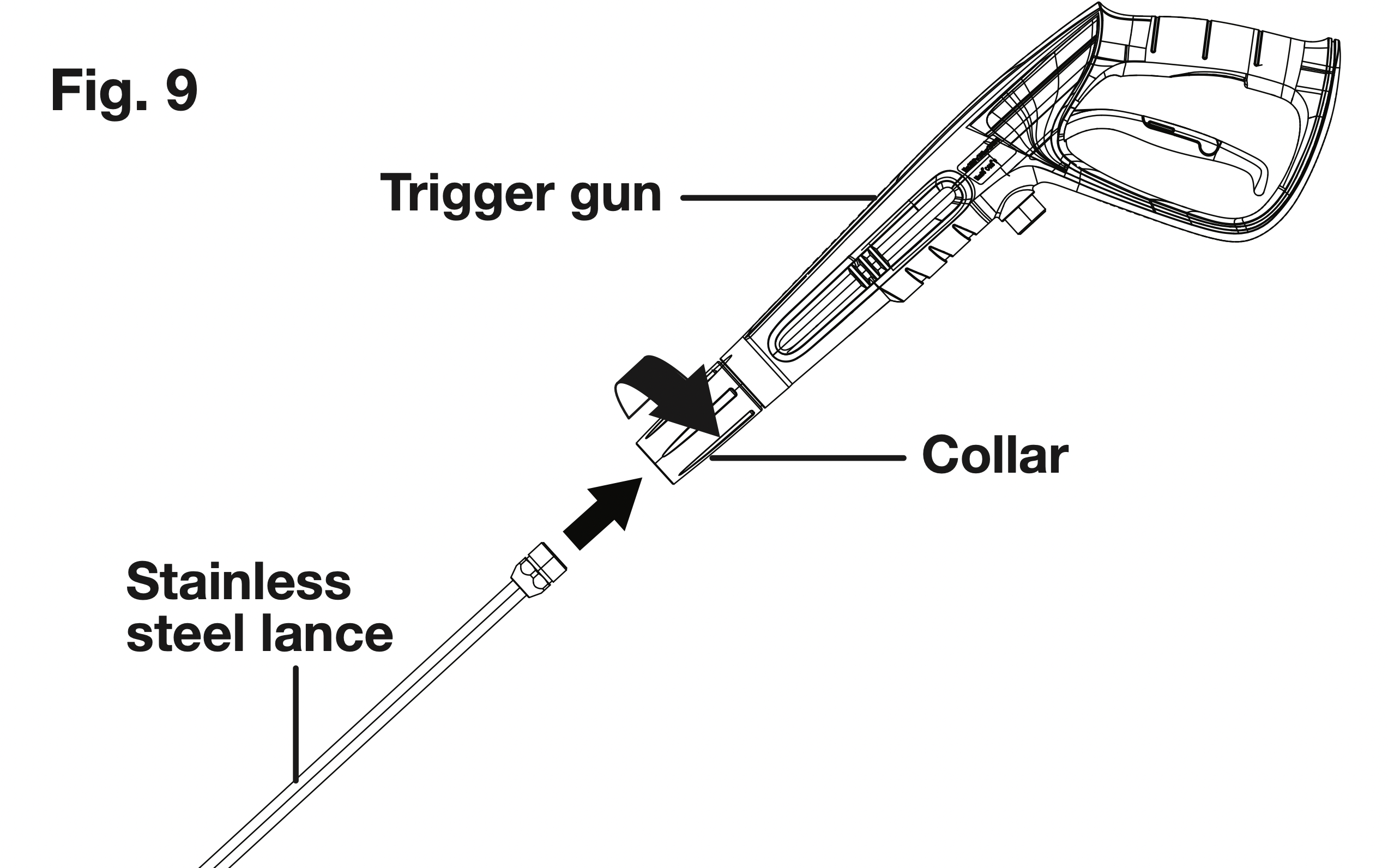
- Connect the high-pressure hose to the trigger gun (Fig. 10).
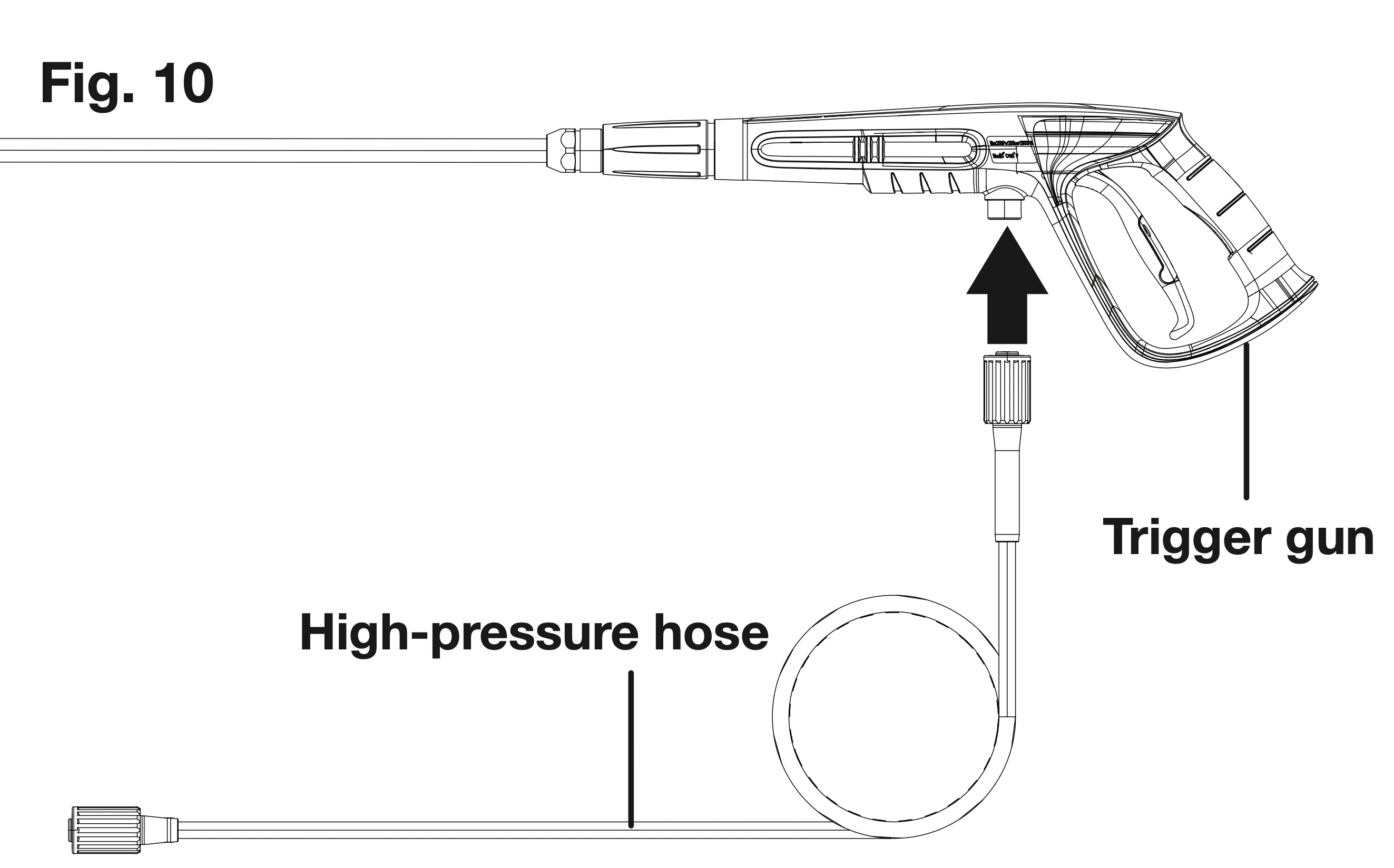
- Connect the high-pressure hose to the water outlet on the washer (Fig. 11).

WARNING! Keep hose away from sharp objects.
Bursting hoses may cause injury. Examine hoses regularly and replace if damaged. Do not attempt to mend a damaged hose. - Connect the garden hose adapter (female coupler) to the water inlet of the pressure washer, then thread your garden hose (male end) into the garden hose adapter (Fig. 12). The garden hose must have an internal diameter of at least 13 mm (1/2 in.) and must be reinforced. The water supply must be at least equal to the washer delivery capacity.

WARNING! The machine is not suitable for connection to the potable water main. - Attach garden hose to water supply (Fig. 13).
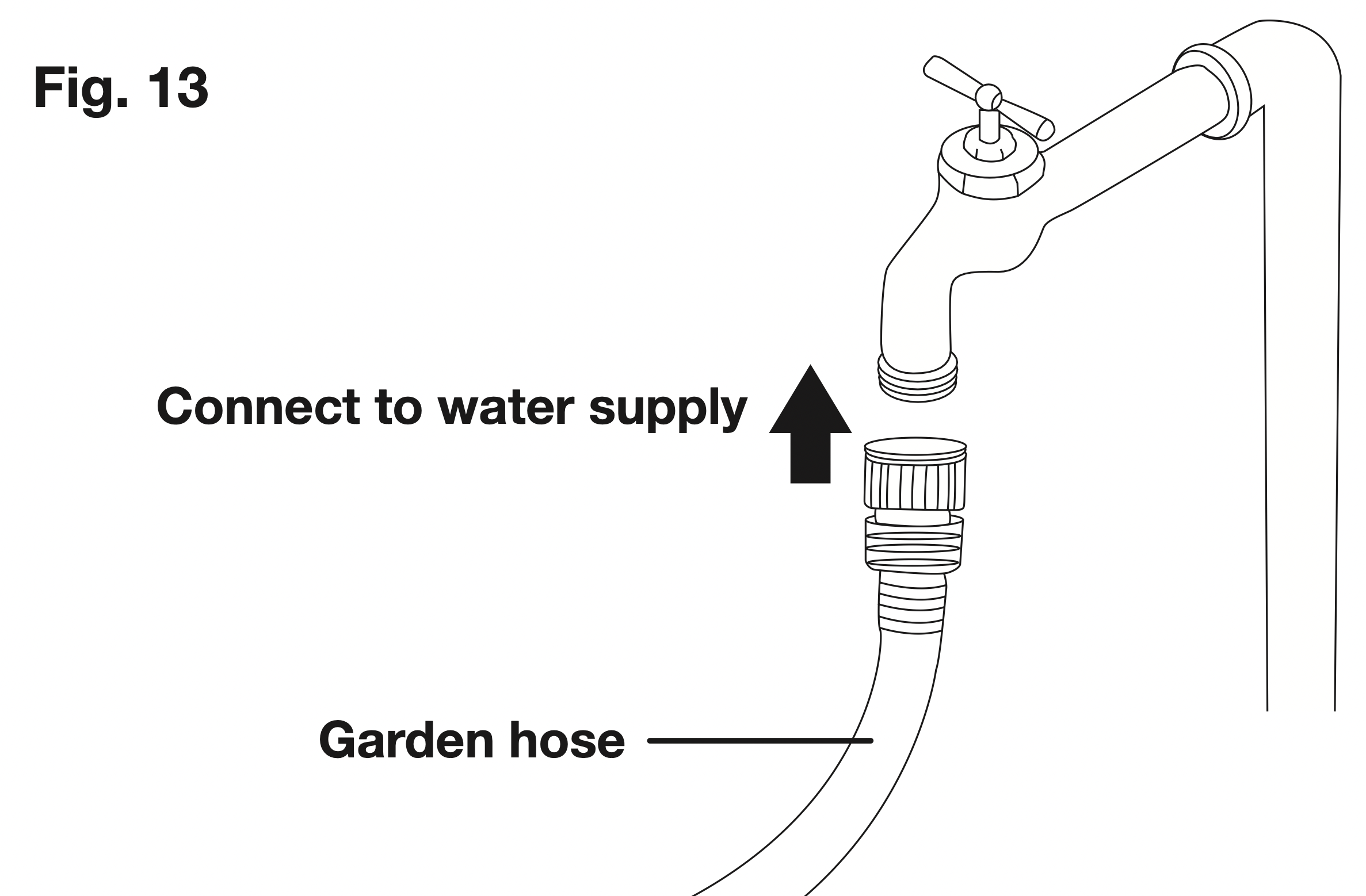
WARNING! The intake water temperature must not exceed 104ºF/40ºC. The water supply must not exceed 0.7 MPa.
CAUTION! The washer must only be used with clean water; use of unfiltered water containing corrosive chemicals will damage the washer. - Make sure the On/Off switch is set to the OFF (0) position before plugging the unit into the power outlet (Fig. 14).
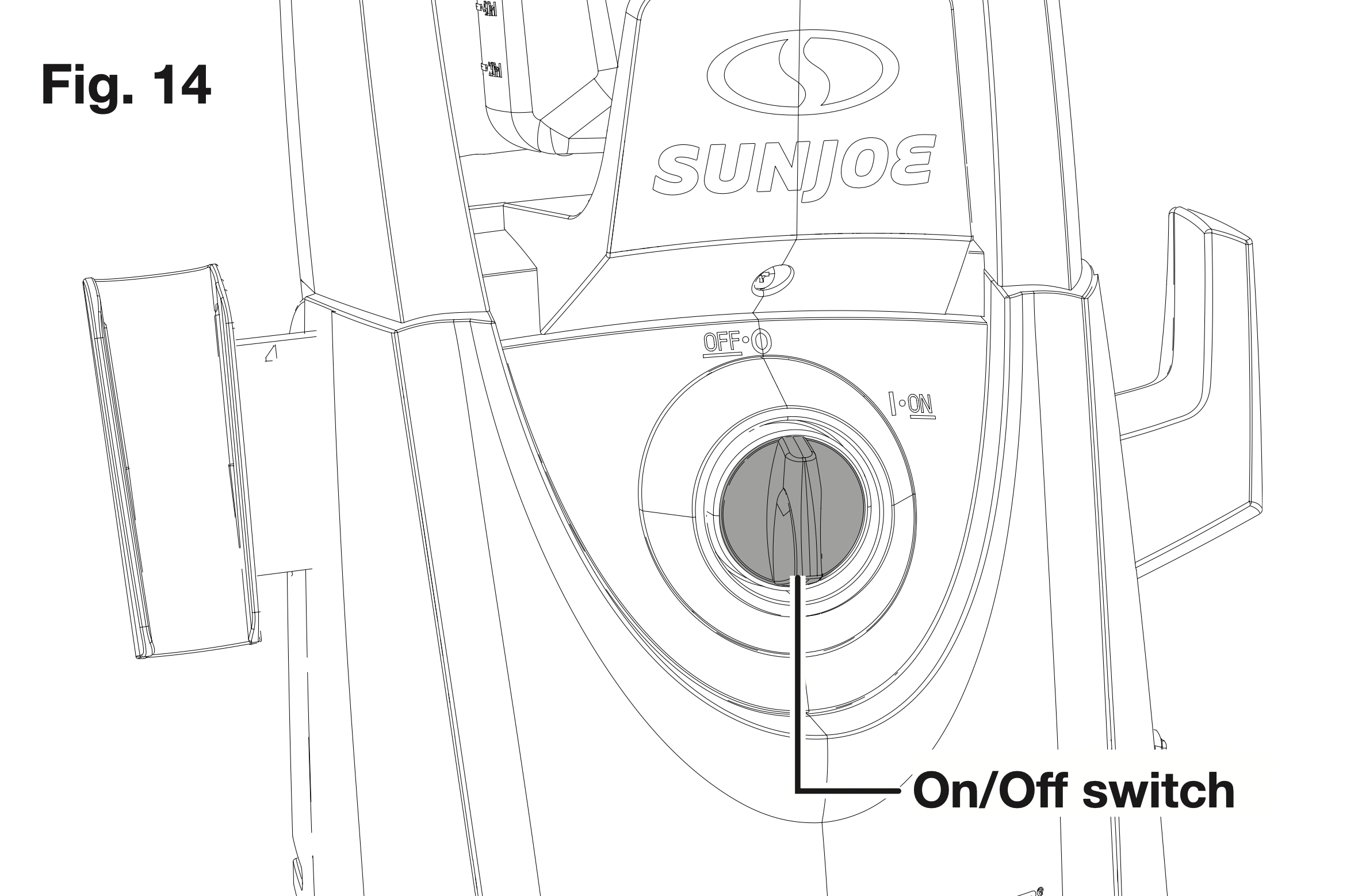
- Check that the electrical supply voltage and frequency (Volt/Hz) correspond to those specified on the pressure washer rating plate. If the power supply is correct, you may now plug the pressure washer into the power outlet (Fig. 15).

NOTE: The GFCI may need to be reset when first plugged into the electric outlet. Press the "Reset" button until the power light indicator on the GFCI illuminates.
Operation
IMPORTANT! This pressure washer is equipped with a micro-switch sensitive to water flow. This Total Stop System (TSS) senses water flow in the pump. When the trigger is released, water stops flowing through the pump. The TSS then automatically turns the motor off to protect the pump from overheating, thus saving energy and prolonging pump life.
- Turn the water supply tap on completely.
- Make sure the safety lock is down and in its original position (Fig. 16), then press the trigger for a few seconds until water flow is steady. This will allow air to escape and discharge any residual pressure in the hose.
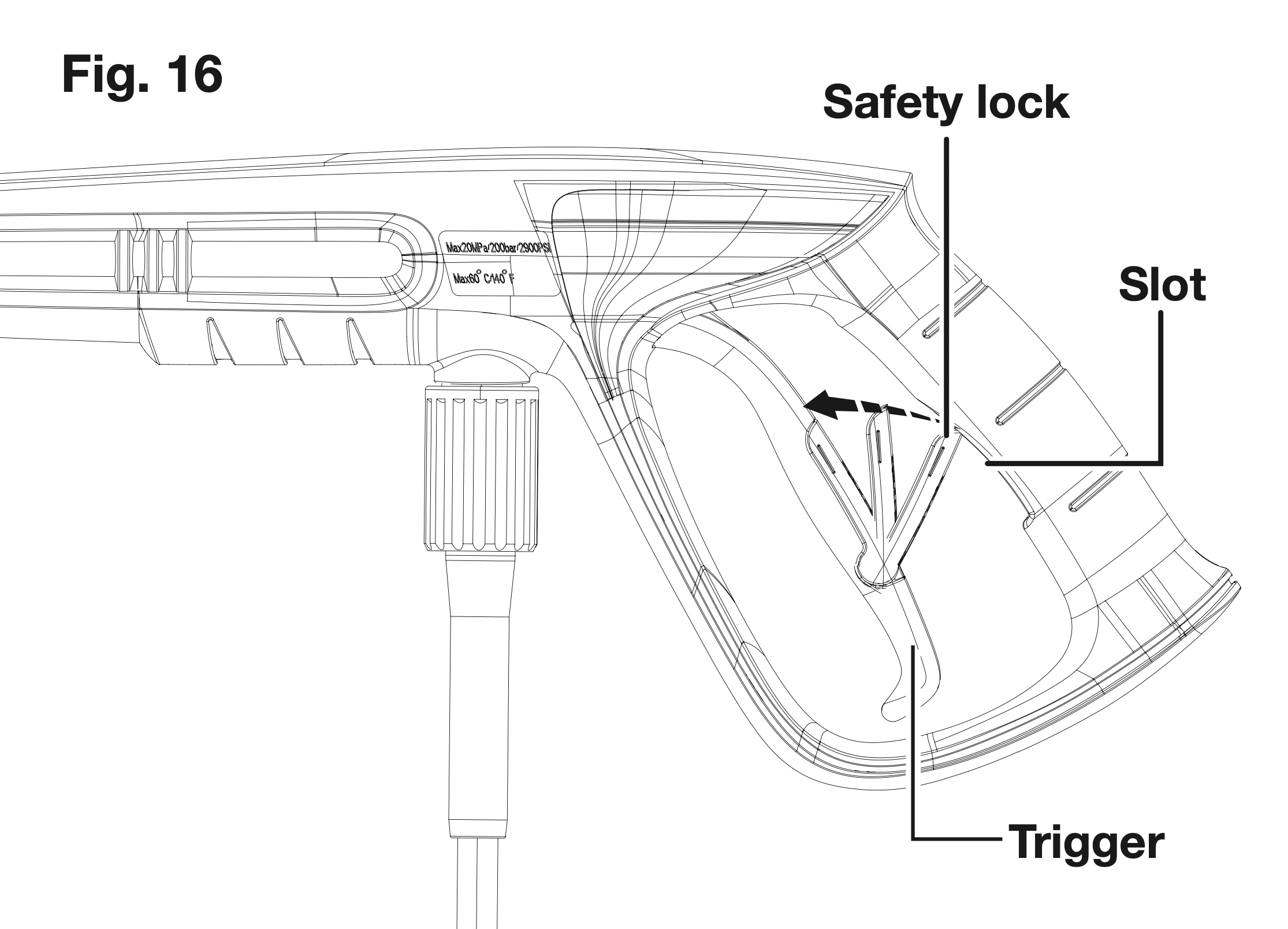
- Turn the switch to the ON (I) position to start the pressure washer (Fig. 17).
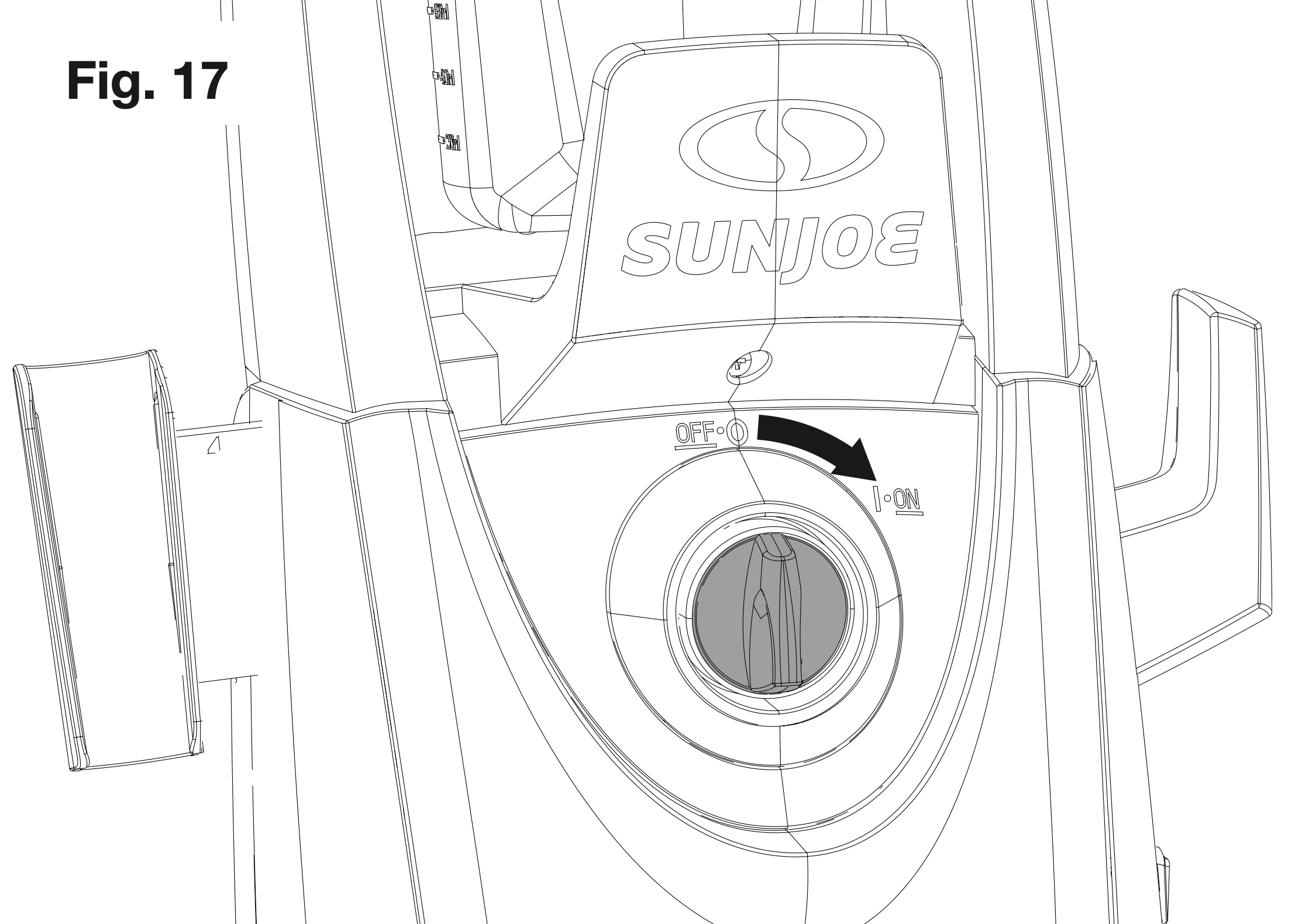
Using the Nozzles
Before beginning any cleaning task, determine the best nozzle for the job. Each of the nozzles has a different spray pattern. The nozzle patterns are 40˚ (for gentle cleaning), 25˚ (for all-purpose cleaning), 15˚ (for tough jobs), and the 0˚ (for spot cleaning or hard-to-reach areas).
CAUTION! NEVER change nozzles without locking the safety lock on the trigger handle.
WARNING! High-pressure jets can be dangerous if subject to misuse. The jet must not be directed at persons, pets, live electrical equipment, or the appliance itself.
This electric pressure washer is equipped with four (4) QuickConnect nozzles that easily snap onto the Quick-Connect collar of the stainless steel lance.
To connect a nozzle to the stainless steel lance:
- Turn off the pressure washer and shut off the water supply. Pull the trigger to release water pressure.
- Engage the safety lock on the trigger handle by pushing up on the safety lock until it clicks into the slot (Fig. 18).

- Snap the desired nozzle onto the Quick-Connect collar until it clicks into place (Fig. 19).
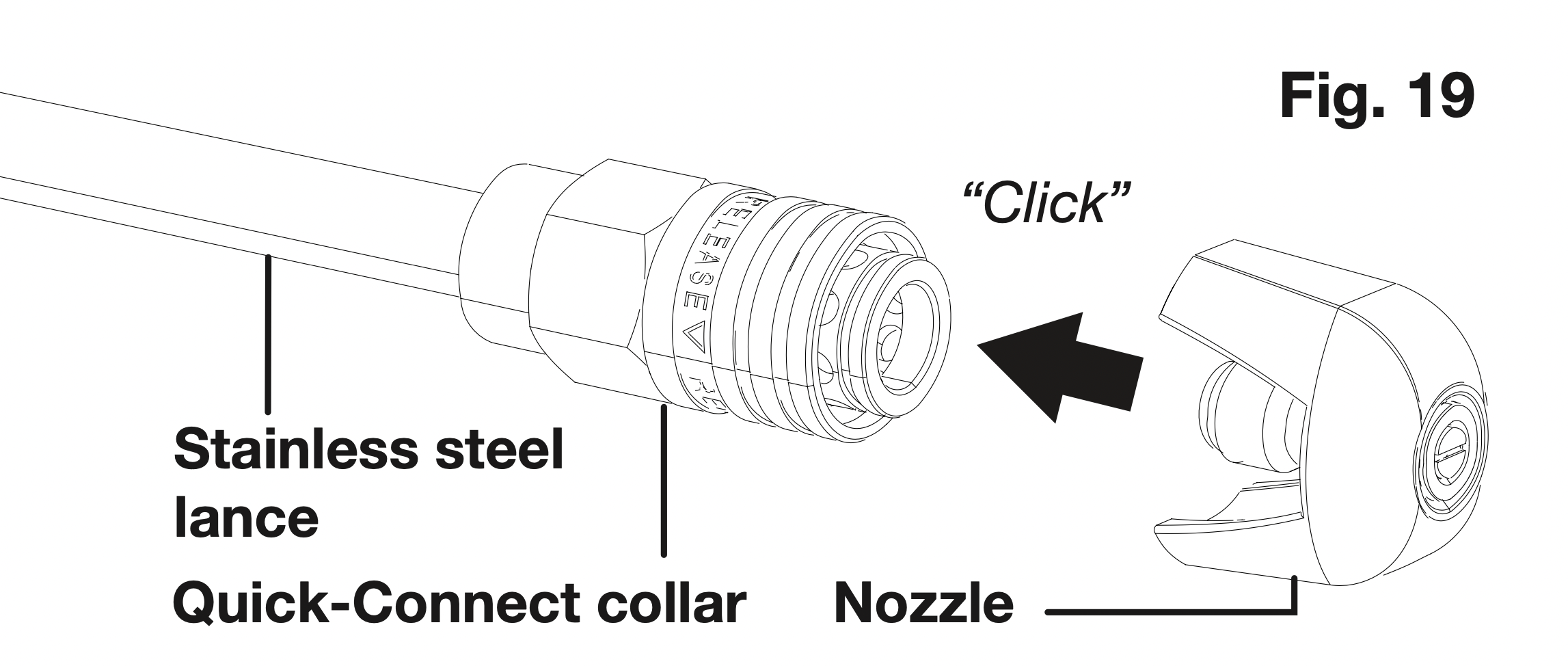
To disconnect a nozzle from the stainless steel lance once the cleaning job is complete: - Turn off the pressure washer and shut off the water supply. Pull the trigger to release water pressure.
- Engage the safety lock on the trigger handle by pushing up on the safety lock until it clicks into the slot (Fig. 18).
- Remove the nozzle by placing your hand over the nozzle while pulling back on the Quick-Connect collar.
WARNING! Do not make changes to the nozzle while the trigger is engaged. Doing so could result in damage to the pressure washer or injury to the user.
Working with Detergents
When cleaning with the pressure washer, some cleaning tasks can be solved with water alone, but for most tasks cleaning with detergent allows for more effective dirt removal.
For additional cleaning power, the unit comes equipped with a detergent spray bottle.
WARNING! Use only detergents specifically designed for use with pressure washers, such as Sun Joe ® HOUSE + DECK WASH (SPX-HDC1G), Sun Joe ® SNOW FOAM AUTO WASH (SPX-FCS1G), or Sun Joe ® HEAVY DUTY CLEANER (SPX-APC1G). DO NOT USE household detergents, acids, alkaline solutions, bleaches, solvents, flammable material, or industrial grade solutions. These could damage the pressure washer. Many detergents may require mixing prior to use. Prepare the cleaning solution as instructed on the solution bottle.
- Remove the detergent bottle with foam cannon from the nozzle storage board. Remove the foam cannon cap with detergent suction tube from the detergent bottle.
- Fill the detergent tank with detergent designed specifically for use with pressure washers (Fig. 20).

- Recap the detergent bottle, and attach it to the stainless steel lance by snapping it onto the Quick-Connect collar until it clicks into place (Fig. 21).
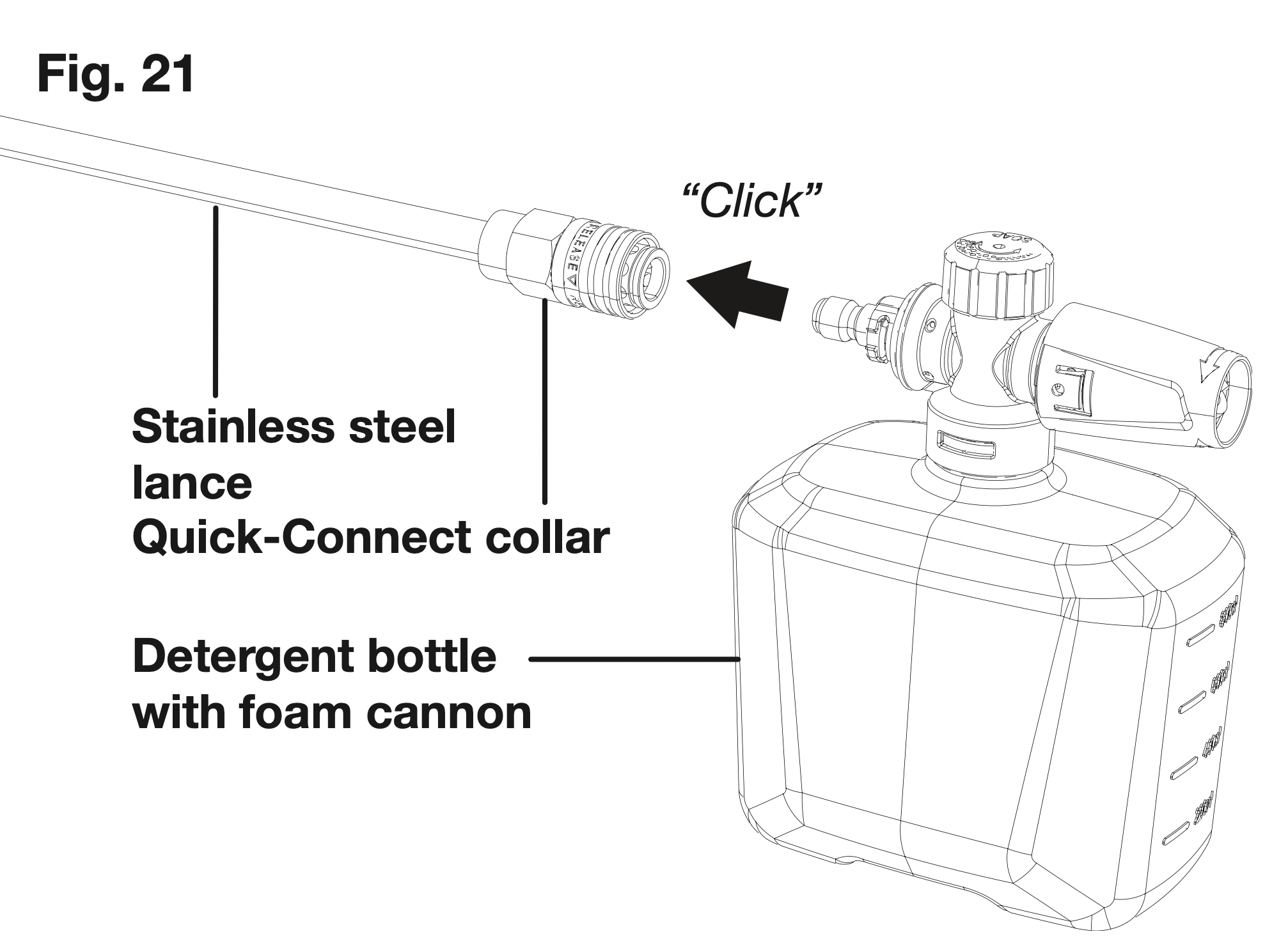
- The foam cannon is featured with a foam-volume adjustable knob. Follow the instructions as shown to use the foam-volume adjustable knob (Fig. 22).

- Apply detergent from the bottom to the top of the dry surface to be cleaned. Applying detergent in this manner will dissolve dirt most effectively.
NOTE: Wetting the surface first is not recommended as it dilutes the detergent and reduces its cleaning ability.
CAUTION! Always test the detergent in an inconspicuous area before use. - Allow the detergent to remain on the surface for a short time before rinsing with the pressure washer. Do not allow the detergent to dry on the surface.
CAUTION! Damage may occur to painted surfaces if the detergent is allowed to dry on the surface. Wash and rinse a small section at a time. Avoid working on hot surfaces or in direct sunlight.
Rinsing with the Pressure Washer
- Turn off the pressure washer and shut off the water supply.
- Pull the trigger to release water pressure.
- Engage the safety lock on the trigger handle by pushing up on the safety lock until it clicks into the slot (Fig. 18).

- Remove the detergent bottle with foam cannon by holding the bottle while pulling back on the Quick-Connect collar.
- Select the right nozzle for the job (Fig. 23):

i) The 0º intense-jet nozzle (red) is an extremely powerful nozzle that delivers a high-pressure, pencil-point jet stream. It is used to cut heavy dirt deposits in a small, concentrated area. It is ideal for dissolving stubborn substances, like tar and grease spots on concrete, or for removing caked mud from equipment. Use this nozzle to clean hard-to-reach areas including the facades of 2-story buildings or the undersides of lawn mowers and tractors.
NOTE: Care should be used when choosing the right nozzle to avoid permanently gouging wood or damaging fragile surfaces.
ii) Use the 15º fan-tip nozzle (yellow) for intense cleaning jobs on hard surfaces. Applications include stripping paint, removing oil stains, grease, heavy mildew stains, and rust from steel. This nozzle should only be used in areas that can withstand the high-pressure from this nozzle.
iii) Use the 25º fan-tip nozzle (green) to clean home siding, brick patios, wood decks, driveways, or sidewalks. When using this nozzle, test a small area first to avoid surface damage.
iv) Use the 40º wide-spray tip nozzle (gray) to clean items such as cars, trucks, boats, patio furniture, or lawn equipment. - Start at the top of the area to be rinsed and work your way down, making sure to overlap your strokes.\
IMPORTANT! NEVER USE:
- Bleach, chlorine products, and other corrosive chemicals
- Liquids containing solvents (e.g. paint thinners, gasoline, oils)
- Tri-sodium phosphate products
- Ammonia products
- Acid-based products
These chemicals will harm the unit and will damage the cleaning surface.
Shutting Down
- Turn the switch to the OFF (0) position and unplug the power cord from the outlet.
- Turn off the water source.
- Hold the trigger to release water pressure.
- Disconnect the garden hose from the water inlet on the unit.
- Disconnect the high-pressure hose connection on the trigger gun handle.
- Release the trigger and engage the gun safety lock.
WARNING! Turn off the water supply and squeeze the trigger to depressurize the unit. Failure to do so could result in personal injury due to discharge of high-pressure water.
Taking a Break
If you are taking a break of five minutes or more between cleaning tasks:
- Engage the gun safety lock (Fig. 18).
- Turn the switch to the OFF (0) position.
- Unplug the power cord from the outlet.
Storage
CAUTION! Always store your pressure washer in a location where the temperature will not fall below 32ºF (0ºC). The pump in this machine is susceptible to permanent damage if it freezes. FREEZE DAMAGE IS NOT COVERED BY THE WARRANTY.
- Store the pressure washer indoors in a dry, covered area where it is not subject to adverse weather conditions.
- It is important to store this product in a frost-free area.
- Always empty water from all hoses, the pump, and the detergent bottle before storing.
CAUTION! The use of a pump protector is recommended to prevent cold weather damage during storage over the winter months.
Winterizing + Long-Term Storage
If you must store your pressure washer in a location where the temperature falls below 32ºF (0ºC), you can minimize the chance of damage to your machine by utilizing the following procedure:
- Disconnect all water connections.
- Turn on the machine for a few seconds until the remaining water in the pump exits. Turn off immediately.
- Do not allow the high-pressure hose to become kinked.
- Store the machine and accessories in a room that does not reach freezing temperatures.
- Do not store near a furnace or other sources of heat that may dry out the pump seals.
- Operate the pressure washer with non-corrosive/non-toxic anti-freeze, a pump saver, or a pump protector before storing for the winter.
WARNING! Before reusing, completely flush the unit out with clear water. Anti-freeze products can damage paintwork, so you must ensure there is no anti-freeze left in the system before using it again.
Maintenance
CAUTION! Before working on the pressure washer, disconnect the plug from the power supply socket.
- To ensure good performance, check and clean the water inlet filter (Fig. 24). Remove the pre-filter and water inlet filter and rinse with warm water to prevent any foreign matter from clogging the pump (Figs. 25 – 26).
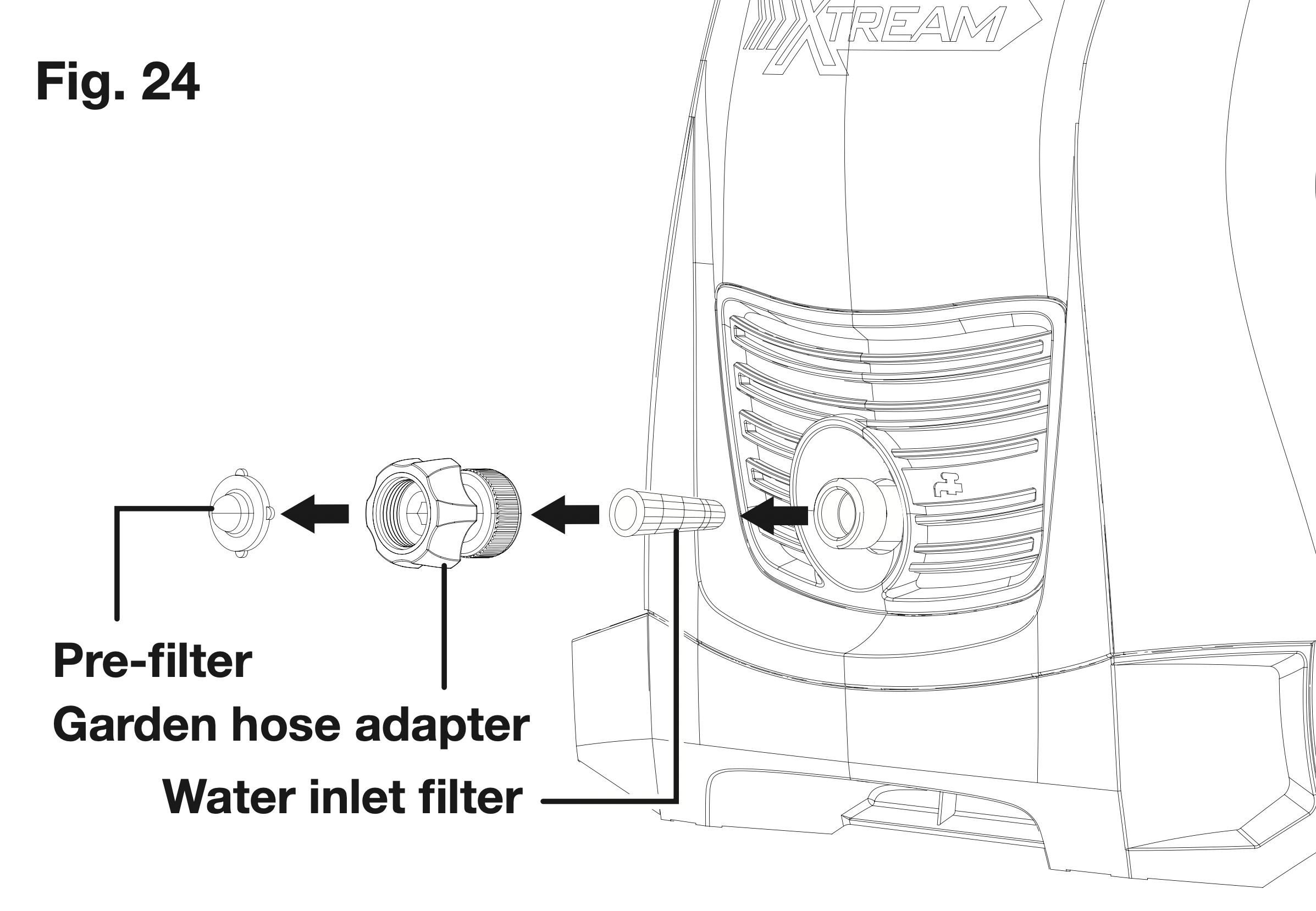
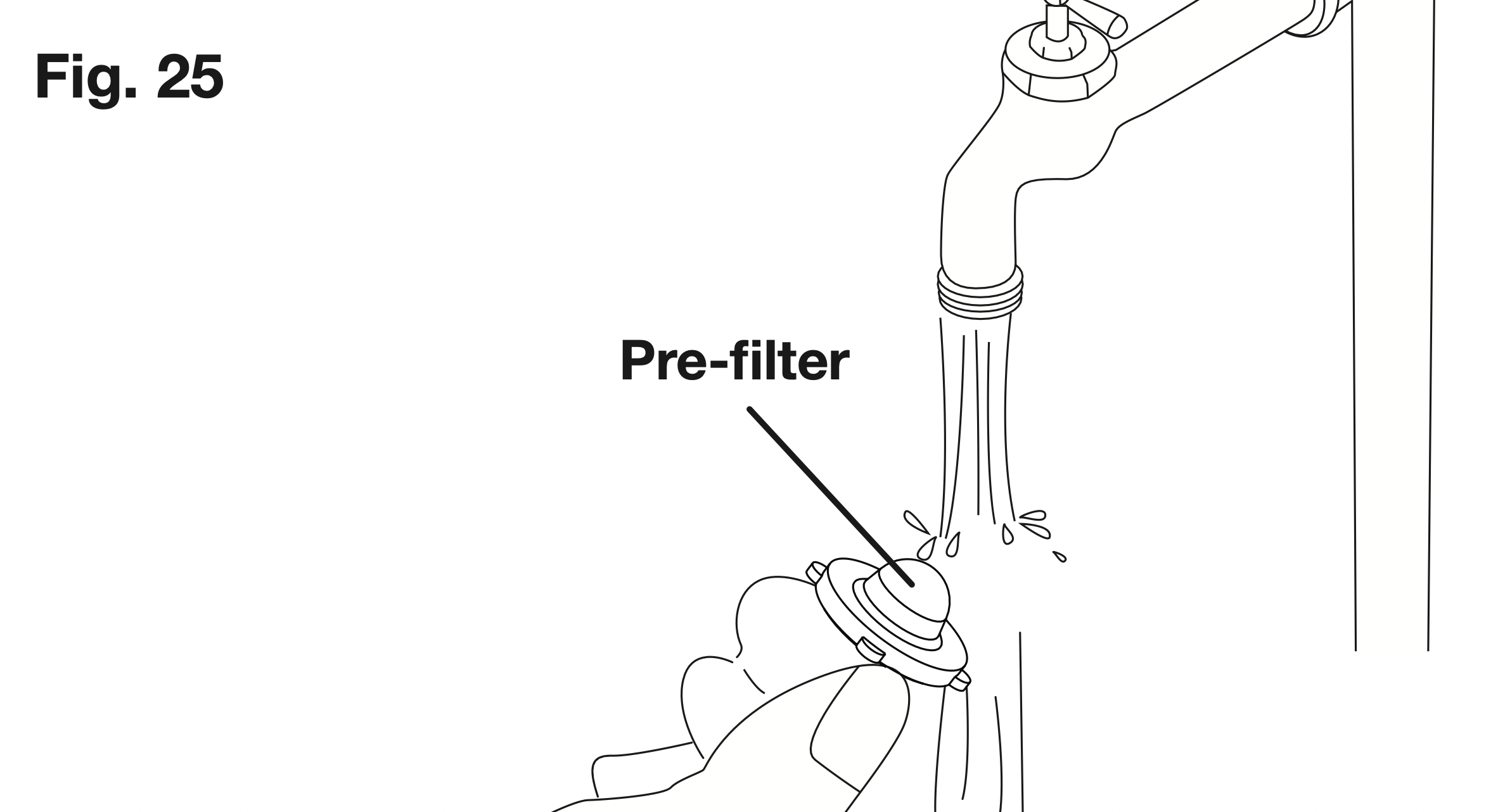
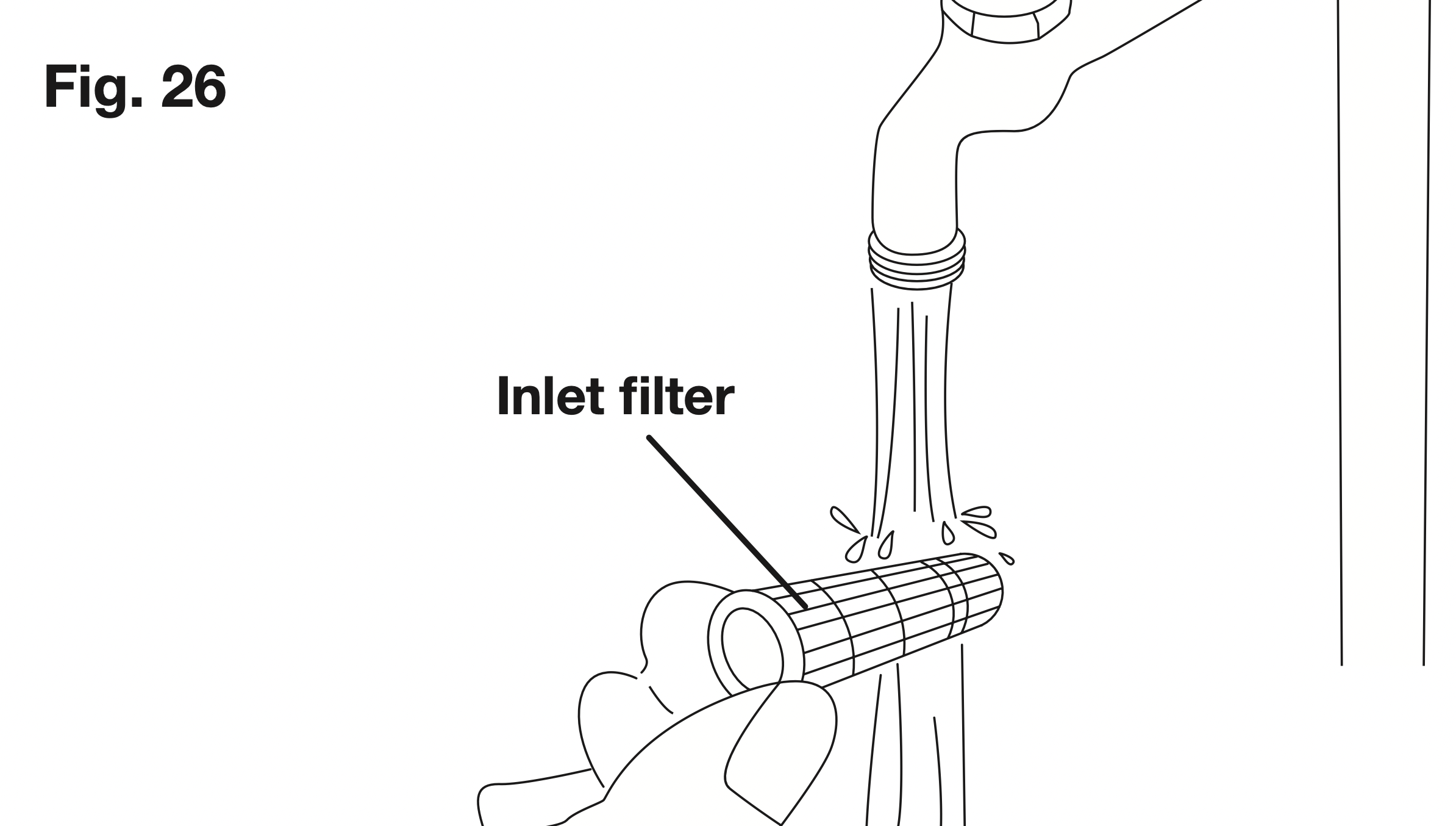
- Clean the nozzle with the needle clean-out tool provided (Fig. 27). Remove the stainless steel lance from the gun; remove any dirt from the nozzle hole and rinse.
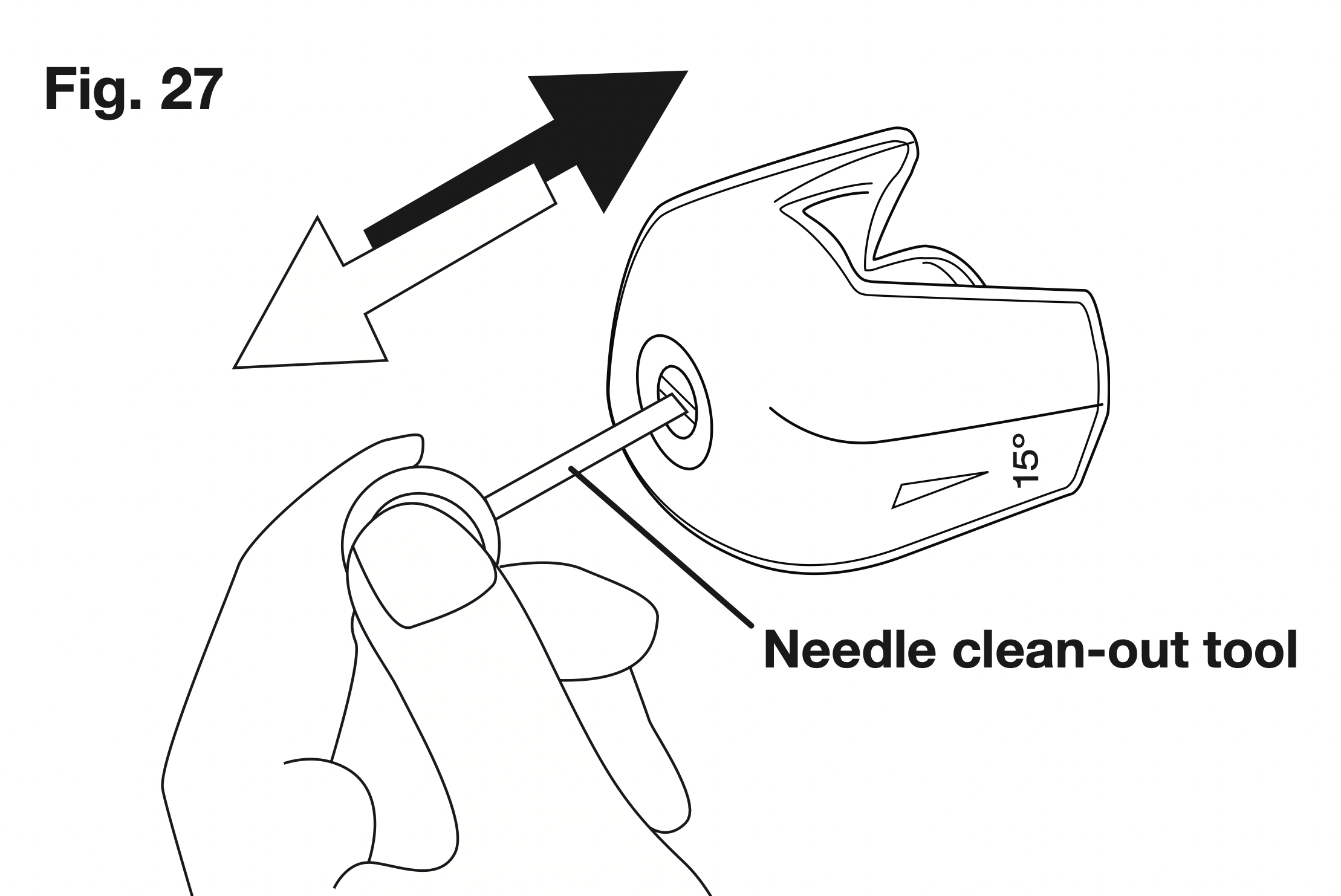
- Remove additional debris by back flushing water through the nozzle and stainless steel lance. To do this, place the end of your garden hose (with water running) to the tip of the nozzle, pushing water and debris out of the back opening of the nozzle and stainless steel lance.
Disposal
Recycling the Washer
- Do not dispose of electrical appliances as unsorted municipal waste. Use separate collection facilities.
- Contact your local government agency for information regarding the collection systems available.
- If electrical appliances are disposed of in landfills or dumps, hazardous substances can leak into the groundwater and get into the food chain, damaging your health and well-being.
- When replacing old appliances with new ones, the retailer is legally obligated to take back your old appliance for disposal at least free of charge.
Troubleshooting
- Disconnect the unit from the electrical power supply before carrying out maintenance on the machine or when checking that its parts are in proper working order.
- The hose must be connected and the water turned on before operating your unit. Failure to do so will damage the pump motor and void your warranty.
- Total Stop System (TSS) – The motor will shut OFF and remain in standby mode during periods of inactivity, or as soon as the unit is pressurized. THIS IS NORMAL. Simply squeeze the trigger to restart the pump motor.
- To avoid unnecessary hassles, consult the following table before contacting customer service with any mechanical issues.
| Problems |
Possible Cause |
Possible Solution |
|---|---|---|
|
Machine refuses to start |
|
|
|
Fluctuating pressure |
|
|
|
Machine stops |
|
|
|
Fuse blows |
|
|
|
Machine pulsating |
|
|
|
Machine often starts and stops by itself |
|
|
|
Machine starts, but no water comes out |
|
|
